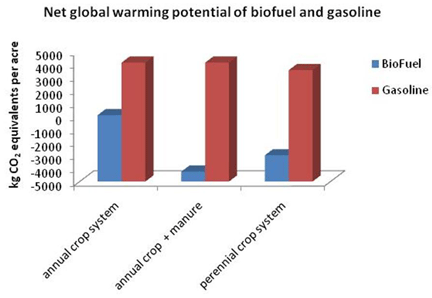Why biofuels are better for the environment
Editor’s note: This article is from the archives of the MSU Crop Advisory Team Alerts. Check the label of any pesticide referenced to ensure your use is included.
Recent popular press articles have blamed U.S. agricultural ethanol production on causing global warming, primarily due to the indirect effect of causing deforestation of tropical rain forests. This type of narrowly focused, indirect analysis is fraught with error, lacking in science, and ultimately leads to poor policy. In fact, with an indirect analysis narrowly focused on environmental effects, we would conclude that things like public education, baseball and hospitals are all bad ideas since they too contribute to global warming. Of course, this is absurd, but it underscores why we need to apply a more direct analysis when evaluating the environmental effects of new technologies and not restrict indirect analysis to a narrowly defined scope.
What are the direct net global warming effects of producing ethanol? Based on research conducted at Michigan State University and elsewhere, ethanol is a far superior alternative to petroleum-based fuels with regard to environmental global warming potential (GWP). The figure below shows the net GWP of annual crop (corn) and perennial crop (switchgrass) biofuel cropping systems, relative to the gasoline the harvested biofuels displace. A negative net GWP number means that the system is actually taking greenhouse gases such as carbon dioxide (CO2), methane (CH4) and nitrous oxides (NOx) out of the atmosphere. A positive net GWP number means that gases are being added to the atmosphere and net global warming potential increases.
The data clearly show that the biofuel systems improve GWP relative to using gasoline. How can this be? The mechanism involved is based on photosynthesis. Carbon that is released to the atmosphere from combusting biofuels is carbon that was photosynthetically produced in the first place. In other words, the corn and switchgrass that produced the ethanol acquired the carbon from the air to make the starch and cellulose that produced the ethanol. Of course, some new carbon (from petrochemical sources) was used in the manufacturing and transporting of the fertilizers, herbicides and other inputs to grow the corn and switchgrass, and petrochemicals were also used in field operations to plant and harvest the crops and to process them into ethanol. All these inputs need to be included in the evaluation of net GWP and this explains why annual crop systems that do not return sufficient crop residue to the soil can have a slightly positive GWP. However, if the farmer uses good management practices, he can overcome the input carbon debt, and then some, by properly managing the carbon present in the crop residue.
Conservation based farming practices such as no-till can result in net carbon removal from the atmosphere by sequestering (storing) carbon in the soil. Perennial crops such as switchgrass have more extensive root systems relative to annual crops and subsequently partition more photosynthetically derived atmospheric carbon into the soil. The same process explains how cropping systems using manure can have a net negative GWP. When appropriately used as a soil amendment, manure can effectively transfer atmospheric carbon to the soil. Carbon emissions associated with manure include, CH4 emissions (flatulence) from the livestock, CH4 and NOx generated during manure storage and application, and the diesel and gasoline used in gathering and land applying the manure. The CH4 (and NOx) emitted from livestock and stored manure must be included as a net carbon emission since the atmospheric warming potential of CH4 is greater than that of the CO2 from which the carbon originated. The CO2 released and organic carbon in manure is not assessed as a net emission since it was photosynthetically derived in the first place. Conversely, when gasoline is combusted, the carbon that is emitted into the atmosphere is new carbon, carbon that was safely sequestered (for millions of years) far below the earth’s crust. All this new carbon deposited in the atmosphere from years of burning petroleum-based fuels is a major source of our global warming problem today. Every time we choose biofuel as an alternative to gasoline, we displace a new carbon emission from the gasoline with a recycled carbon emission. This direct analysis clearly shows the smaller environmental footprint of biofuels relative to petroleum based fuels. A comprehensive evaluation of the indirect effects of biofuels vs. petroleum based fuels is very complex and far beyond the scope (and space) of this article.
For more information on the indirect effects of biofuel versus petroleum based fuel, I suggest reading Dr. Robert Zubrin’s book entitled Energy Victory, (published by Prometheus Books).
Figure 1. Net global warming potential (kg of CO2 equivalents per acre) of biofuel
cropping systems compared to the GWP of the gasoline displaced by each system.

Annual crop system net GWP data represents annual average of a corn-soy-corn rotation.; grain calculated at 150 bu/acre (420 gal ethanol/acre) + 3.5 ton/acre stover (250 gal ethanol/acre) ; annual crop + manure = same as grain + stover system with manure applied to soil; annual crop systems GWP from MSU field research data, East Lansing, MI.
Perennial crop system was switchgrass calculated at 8 ton/acre (576 gal ethanol/acre) switchgrass net GWP carbon data source was Frank et al. 2004, Crop Sci.
Gasoline displaced was calculated as 0.7x the ethanol produced by each respective cropping system. CO2 values for gasoline were from 40 CFR 600.13.



 Print
Print Email
Email


